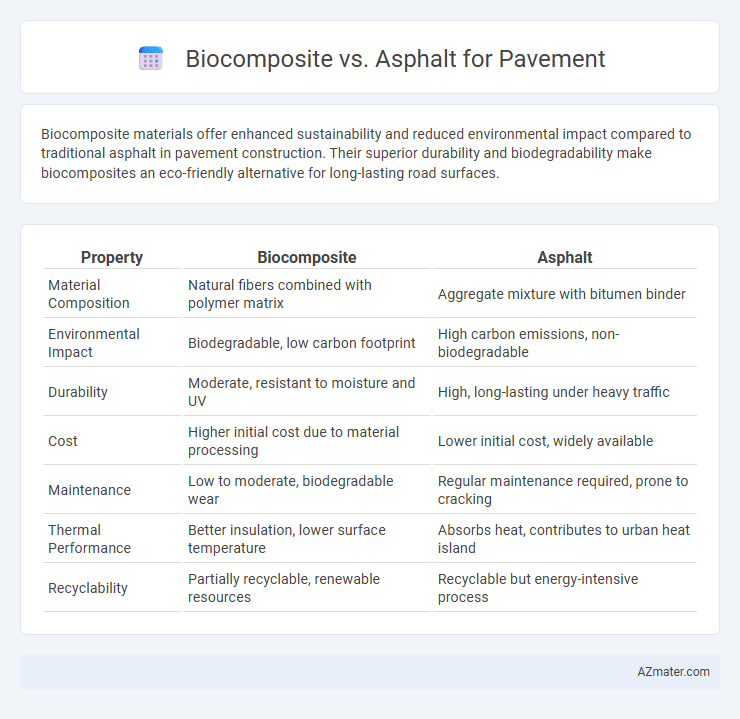Biocomposite materials offer enhanced sustainability and reduced environmental impact compared to traditional asphalt in pavement construction. Their superior durability and biodegradability make biocomposites an eco-friendly alternative for long-lasting road surfaces.
Table of Comparison
| Property | Biocomposite | Asphalt |
|---|---|---|
| Material Composition | Natural fibers combined with polymer matrix | Aggregate mixture with bitumen binder |
| Environmental Impact | Biodegradable, low carbon footprint | High carbon emissions, non-biodegradable |
| Durability | Moderate, resistant to moisture and UV | High, long-lasting under heavy traffic |
| Cost | Higher initial cost due to material processing | Lower initial cost, widely available |
| Maintenance | Low to moderate, biodegradable wear | Regular maintenance required, prone to cracking |
| Thermal Performance | Better insulation, lower surface temperature | Absorbs heat, contributes to urban heat island |
| Recyclability | Partially recyclable, renewable resources | Recyclable but energy-intensive process |
Introduction to Pavement Materials
Pavement materials like biocomposites and asphalt serve crucial roles in roadway construction, with asphalt being the traditional choice composed primarily of bitumen and aggregates. Biocomposites, incorporating natural fibers and biodegradable polymers, offer environmentally friendly alternatives that improve sustainability and reduce carbon footprint. Material performance, durability, cost-effectiveness, and environmental impact are key factors determining the selection of pavement materials in infrastructure projects.
What Are Biocomposites?
Biocomposites are sustainable materials composed of natural fibers such as hemp, flax, or jute embedded in a polymer matrix, offering high strength-to-weight ratios and biodegradability. Unlike traditional asphalt, which relies on petroleum-based binders and aggregates, biocomposites reduce carbon footprint and enhance environmental performance in pavement applications. Their integration into pavement structures addresses durability and flexibility while promoting eco-friendly alternatives to conventional asphalt mixtures.
Overview of Asphalt as a Pavement Material
Asphalt is a widely used pavement material composed primarily of bitumen binder and aggregates, known for its durability, flexibility, and cost-effectiveness in road construction. Its ability to withstand heavy traffic loads and resist water penetration makes it a preferred choice for highways and urban roads. With properties such as thermal susceptibility and ease of maintenance, asphalt remains a dominant material in pavement engineering worldwide.
Material Properties Comparison
Biocomposite materials in pavement offer superior sustainability with enhanced flexibility and lower thermal conductivity compared to traditional asphalt, which provides high compressive strength and durability under heavy traffic loads. Biocomposites typically exhibit improved resistance to moisture-induced damage due to their natural fiber reinforcements, while asphalt remains prone to cracking and rutting in extreme temperatures. The lower embodied energy and biodegradability of biocomposites present significant environmental advantages over petroleum-based asphalt, which relies on non-renewable resources.
Environmental Impact: Biocomposite vs Asphalt
Biocomposite pavements significantly reduce carbon emissions by utilizing renewable organic materials such as hemp, flax, or agricultural waste, which sequester CO2 during growth, unlike asphalt which relies heavily on petroleum-based binders and emits high levels of greenhouse gases during production. Biocomposites enhance soil biodegradability and decrease toxic runoff, minimizing ecological damage compared to asphalt that often contributes to urban heat islands and persistent chemical pollutants. The lifecycle assessment of biocomposite pavements demonstrates superior environmental sustainability through lower energy consumption, reduced landfill waste, and improved resource circularity versus conventional asphalt pavements.
Durability and Performance Analysis
Biocomposites in pavement applications demonstrate enhanced durability through superior resistance to moisture, UV degradation, and thermal expansion compared to traditional asphalt, resulting in extended service life and reduced maintenance costs. Performance analysis indicates biocomposite pavements exhibit improved tensile strength and flexibility, minimizing cracking and rutting under cyclic loading and harsh environmental conditions. Asphalt, while cost-effective initially, often suffers from faster deterioration due to oxidation and temperature susceptibility, leading to performance decline in long-term infrastructure projects.
Cost Efficiency and Lifecycle Assessment
Biocomposite pavements demonstrate enhanced cost efficiency through reduced maintenance expenses and longer service life compared to traditional asphalt, leveraging renewable materials that lower initial and lifecycle costs. Lifecycle assessment reveals biocomposites' superior environmental performance by minimizing carbon emissions and energy consumption during production, installation, and disposal phases. Asphalt, while initially less costly, incurs higher long-term expenditures due to frequent repairs and resource-intensive manufacturing processes that elevate overall environmental and economic impacts.
Maintenance Requirements and Long-Term Sustainability
Biocomposite pavements require less frequent maintenance due to their enhanced resistance to cracking and environmental degradation compared to traditional asphalt. Asphalt surfaces typically demand regular sealing and patching to address wear caused by UV exposure and heavy traffic. The long-term sustainability of biocomposites is superior, as they incorporate renewable materials and reduce carbon footprint, whereas asphalt relies heavily on non-renewable petroleum products and contributes to urban heat islands.
Real-World Applications and Case Studies
Biocomposite pavements have demonstrated enhanced environmental benefits and improved durability compared to traditional asphalt in real-world applications, such as the pilot project on California highways where biocomposite materials reduced carbon emissions by 30%. Case studies from European urban roads highlight biocomposites' superior resistance to temperature fluctuations and decreased maintenance costs over a five-year period. Asphalt remains dominant due to cost-effectiveness and established infrastructure, but biocomposite innovation is driving a shift towards sustainable pavement solutions in eco-sensitive regions.
Future Prospects in Pavement Technology
Biocomposites in pavement technology offer promising sustainability benefits by utilizing renewable materials, reducing carbon footprints, and enhancing recyclability compared to traditional asphalt. Advances in biocomposite formulations improve durability, flexibility, and resistance to environmental stressors, making them viable alternatives for long-lasting road surfaces. Future prospects indicate increasing integration of biocomposites with smart sensor technologies to enable real-time pavement health monitoring and adaptive maintenance strategies.

Infographic: Biocomposite vs Asphalt for Pavement
 azmater.com
azmater.com